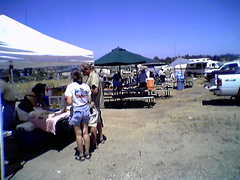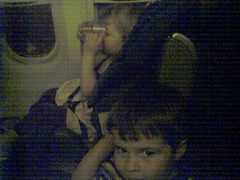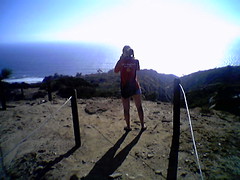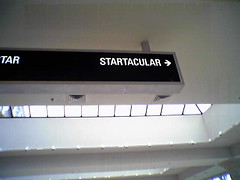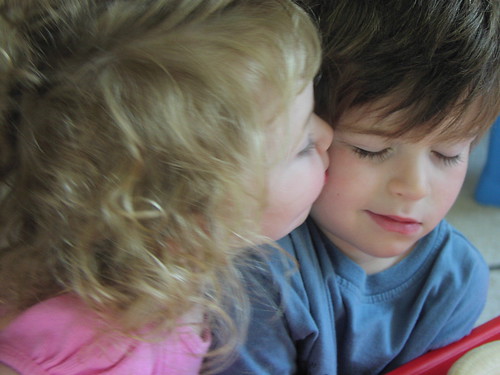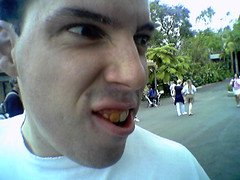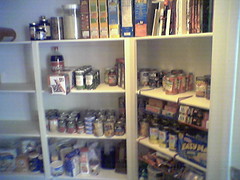This is the first year that I've been able to participate in the full-blown operation. As a lurker, I took full advantage of the Seinfeld philosophy of when some people know your name, and when some people know your face, you can get away with a lot with the complicity of the people that can put the name WITH the face. I hope that made sense. If not, apply Merlot and it should become clear.
Interestingly to some, I didn't operate a station on the air this year. I instead volunteered to help run the Roadkill Cafe, which is the mess hall for the encampment. I was the event co-chair, but the other chair did the vast majority of the work (sleep in, still win!).
I packed the xTerra Friday morning with camp stove, portable kitchen, tent (more on that later), cot, sleeping bag, change of clothes, bag of various stuff like hair and tooth brushes, ear plugs, and Viagra. Just kidding! Purell hand cleanser, towel (never forget your towel - mine was yellow and came in handy multiple times), fuel for the stove, lantern, 40 lbs of water in a big blue container, radio, ipod, chargers, batteries, Franklin Planner, and folding chair.
I drove to the site with the kids, unpacked, talked to everyone, admired all the hard work going on to put up the towers, drove back to my part of town, dropped kids off at gym, went on date with Ken to Sears, bought Hoover floor scrubber, looked at the router tables, argued about Franklin Planner, had ice cream, picked up kids, went back home, had good night's sleep.
Saturday morning I baked the recipe George posted a couple of days ago. Since the title of the recipe was "Boiled Raisin Cake" and since we were "raising towers", I renamed the three batches I baked as "Boiled Raisin' Tower Cakes". Get it? Raising towers? Raisin cake? Anyone?
Yeah, I got the same response from my fellow hams.
Man, were they popular. If I had not have rationed them, they would have gone fast. I made three types. George, you would have loved it. The first was exactly like the recipe, and was cooked in a rectangular pan. It was almost undercooked at 35 minutes, but my stove tends to cook short, so I'll add another 10 minutes to it next time and see how it goes. The second batch was with splenda instead of sugar, but I used real eggs and Smart Beat butter, which has a better type of fat complex. It was cooked in a square, shallow pan, and had perfect texture at 35 minutes. The last batch was with canned egg whites, splenda sugar substitute, and no-fat butter stuff. It was in a bundt pan, and was a bit dry, but by the second day of Field Day, it was so damn good I couldn't believe it. The several diabetics (more on that later) really loved it. Everyone loved the taste, everyone was amazed at the rich brown texture and the balance between bread and raisins.
Now, I did have to sub in "pumpkin pie spice" for nutmeg, since I didn't have any plain nutmeg, but pumpkin pie spice has nutmeg in it, so I thought it was a good substitute. It's one I've used before, so I thought it would work out ok in the cake.
Anyway, I showed up at the Field Day Site, set up, and waited for the "owner" of the traditional camp kitchen (Mark KF6WTN) to show up. Then we got to work cooking. We cooked all morning, all afternoon, all evening, all night until 10pm. I took a break from 10pm until 1am. It wasn't really sleeping, because sleeping was impossible at that point, but it did the trick. I took over from 1am and managed to provide food all night while shivering in the cold nighttime air.
I learned two things. I need to buy a flashlight. I need to get the missing parts to my tent. I ended up cowering in the mess tent due to Tent Malfunction. I also need to take along a long-sleeved shirt, regardless of the weather forecast.
Anyway, morning arrived, gloriously, and we cooked breakfast and then brunch.
The way these sorts of things work is different than what I previously have done in camping. Usually, you can prep for breakfast, do breakfast, clean up, take a break. Prep for lunch, do lunch, clean up after lunch, take a break, rinse and repeat for dinner etc. However, during an emergency, food is needed round the clock. Any sense of schedule gets thrown out the window. If this had been an actual emergency, we might have had refugees, people added to the communications crews at odd or off times, been ordered to move the entire operation to another location, and other challenges. The kitchen therefore operated as a short-order kitchen with a flexible and slowly-changing menu. We transitioned from breakfast to lunch to dinner to snacks, rather than having hard-handoffs from time to time. It worked really well, and I have to credit my friend Mark, who has run the camp kitchen for several Field Days to date, with developing the philosophy. It worked!
Constant cleaning and maintenance was crucial. If something got dropped into one of the two camp sinks, then it got cleaned. If the garbage filled up, it got pulled and dumped in the central trash area. If someone wanted something, it got cooked. Coffee was constantly on, water was constantly heated, and drinks were available in ice chests the entire time.
My take on it is that if the "event"/emergency lasts 24-48 hours, then this sort of high-availability sort of cooking can be done. Anything after that, and you have to start drawing lines in the sand about shifts and rest. However, for a day or two, you can provide an extremely high level of service without knocking yourself out - as long as you have at least two kitchen people per 50 emergency workers. One person can do it, but it's really hard. More than three, and there is idle time. I don't know exactly how this stacks up with others' experiences, but it worked out really well in this case.
We fielded six complete communications teams, had six stations, six major huge-ass towers with Yagis, etc., operated on all bands, almost all modes, contacted almost all regions of the US, and kept it up for 24 hours solid. We handled all our own power, lighting, food, fluids, entertainment (laugh) and brought our own portapotty with us.
By 1:51pm Sunday, the towers (many quite large) were down and on trailers. By 2:15, all towers were on the road. We scored a cherry-picker vehicle of some sort to help us put the towers up and take them down. The site was left in way better shape than when we found it.
The site this year was a large industrial lot in urban San Diego. It was hard dusty dirt in composition, and had a high elevation. It was right by the freeway, and attracted a lot of attention from passers-by, who visited us and got the Nerd Ham Radio Operator Treatment (NHROT) from various fat white men when they wandered into our grasp.
If you are remotely interested in emergency preparedness, want to test your "go-kit", are thinking about getting a ham radio license, like hanging out with weirdos, miss stressful camping situations, or have a military background, then this might be the annual event for you.
I got four job offers, heard more dirty jokes than I can remember, cooked more food than I do all year, and had a HELL of a good time. And, I didn't even touch a radio. Field Day happens all over, ever year. There is another major emergency drill done by ARRL, so that's two opportunities at least for this sort of zany fun. And, with the rise of CERT teams, you can do it THREE times a year...
OK, maybe that's too much. When the scores are in, I'll let you know how it went...
-Michelle W5NYV qrt

